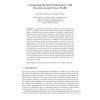Free Online Productivity Tools
i2Speak
i2Symbol
i2OCR
iTex2Img
iWeb2Print
iWeb2Shot
i2Type
iPdf2Split
iPdf2Merge
i2Bopomofo
i2Arabic
i2Style
i2Image
i2PDF
iLatex2Rtf
Sci2ools
ESORICS
2007
Springer
2007
Springer
Countering Statistical Disclosure with Receiver-Bound Cover Traffic
Anonymous communications provides an important privacy service by keeping passive eavesdroppers from linking communicating parties. However, using long-term statistical analysis of traffic sent to and from such a system, it is possible to link senders with their receivers. Cover traffic is an effective, but somewhat limited, counter strategy against this attack. Earlier work in this area proposes that privacysensitive users generate and send cover traffic to the system. However, users are not online all the time and cannot be expected to send consistent levels of cover traffic, drastically reducing the impact of cover traffic. We propose that the mix generate cover traffic that mimics the sending patterns of users in the system. This receiver-bound cover helps to make up for users that aren't there, confusing the attacker. We show through simulation how this makes it difficult for an attacker to discern cover from real traffic and perform attacks based on statistical analysis. Our...
| Added | 16 Aug 2010 |
| Updated | 16 Aug 2010 |
| Type | Conference |
| Year | 2007 |
| Where | ESORICS |
| Authors | Nayantara Mallesh, Matthew Wright |
Comments (0)

